Abstract
A conventional indirect immunofluorescence assay (IFA) and an anticomplement indirect immunofluorescence assay (ACIF) for detecting serum antibodies to Borrelia burgdorferi in humans were evaluated during a prevalence survey in northern California. Sera obtained from 119 current or former residents of an area in which Lyme disease is endemic were split and tested by the IFA in two laboratories and the ACIF in a third. The seropositivity rate ranged from 15 to 20% with 88 to 93% agreement among laboratories. Interlaboratory agreement was statistically highly significant in each of the three pairwise comparisons and was positively associated with clinical manifestations of Lyme disease. Intralaboratory agreement ranged from 93 to 96% in two laboratories and was also statistically highly significant. Immunoblotting confirmed 100 of 101 of the nondiscrepant immunofluorescence test results and likewise was positively correlated with the degree of interlaboratory agreement. The ACIF was found to be a highly specific test (100% specificity) with a much lower cutoff titer (1:8) than the conventional IFA (determined to be 1:128 or 1:256 in two laboratories) for detecting antibodies to B. burgdorferi. It also appeared to be more sensitive (80 versus 68%) than the IFA as determined by comparative immunoblotting, though the absolute sensitivity of the ACIF for serodiagnosis of early Lyme disease has yet to be determined. Significant serologic cross-reactivity was demonstrated between B. burgdorferi, Borrelia coriaceae, and Borrelia hermsii by the IFA, which may confound spirochetal serosurveys in California where all three spirochetes are known to coexist.
Full text
PDF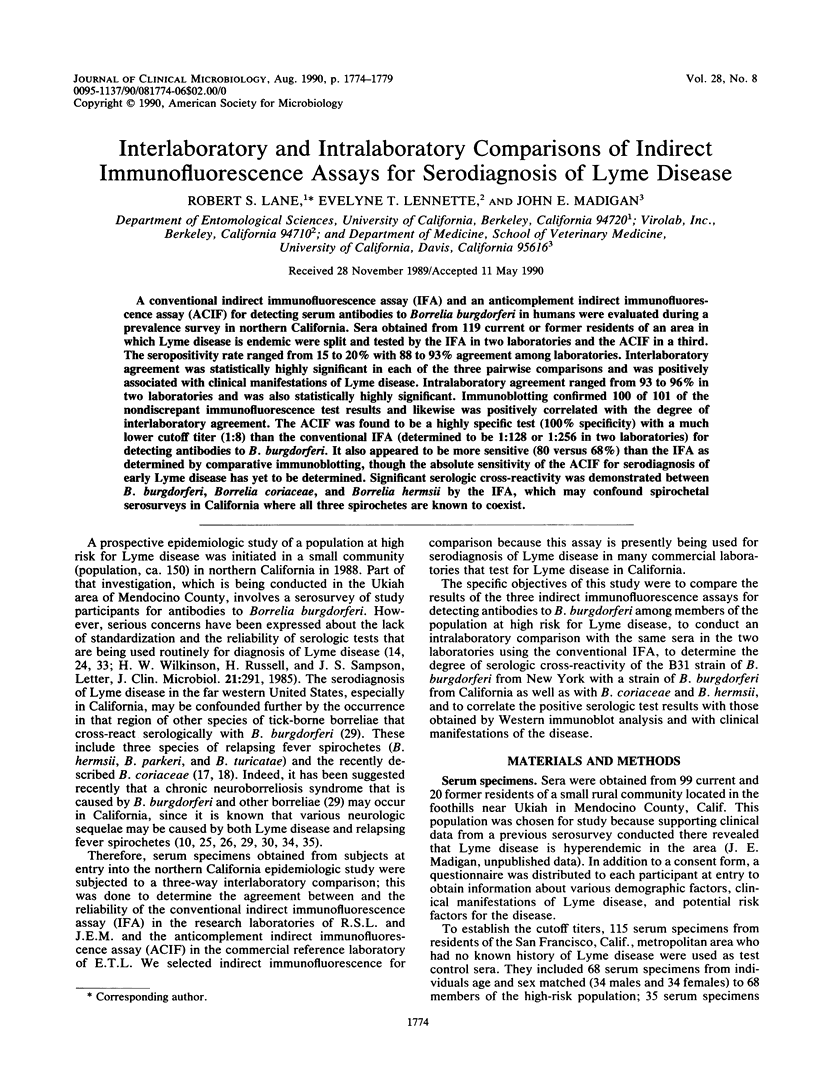
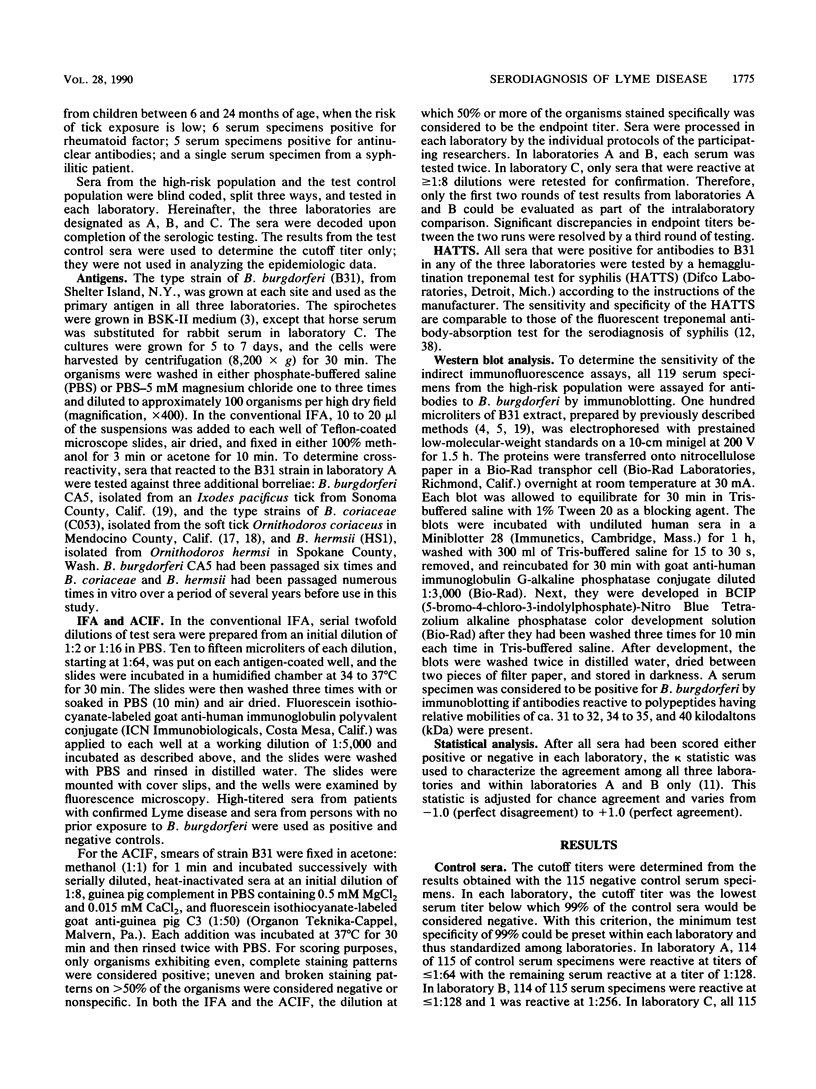
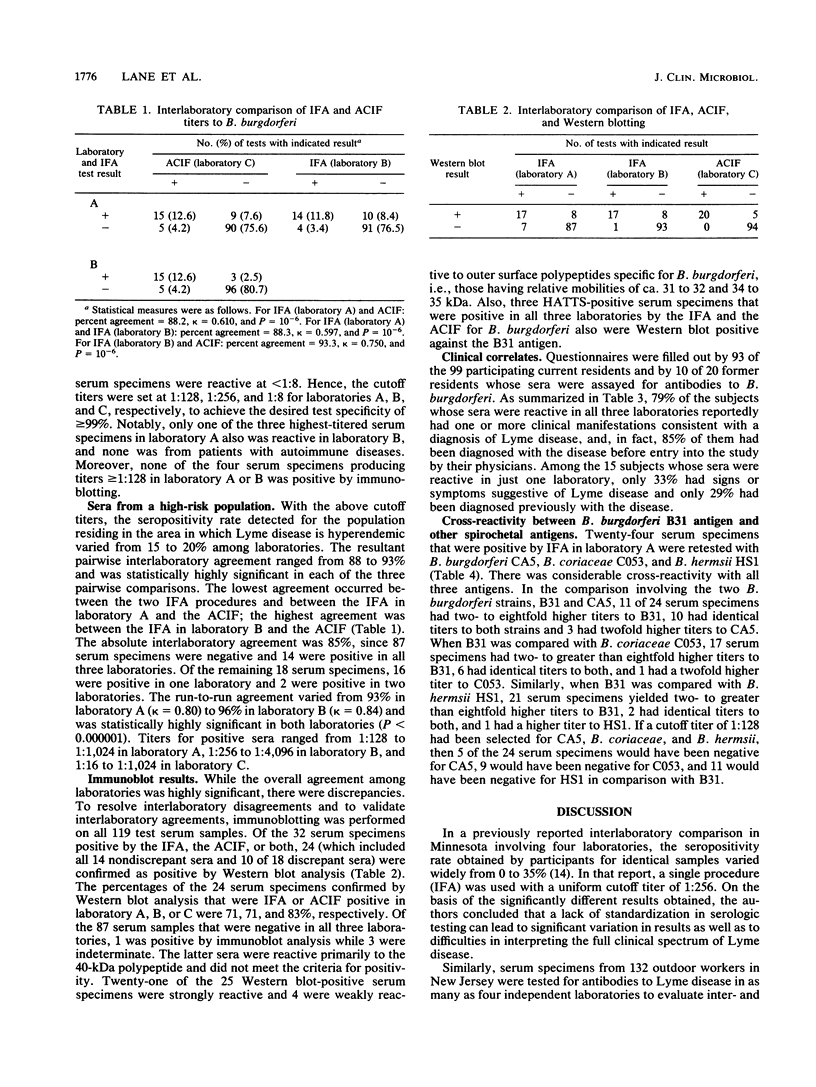
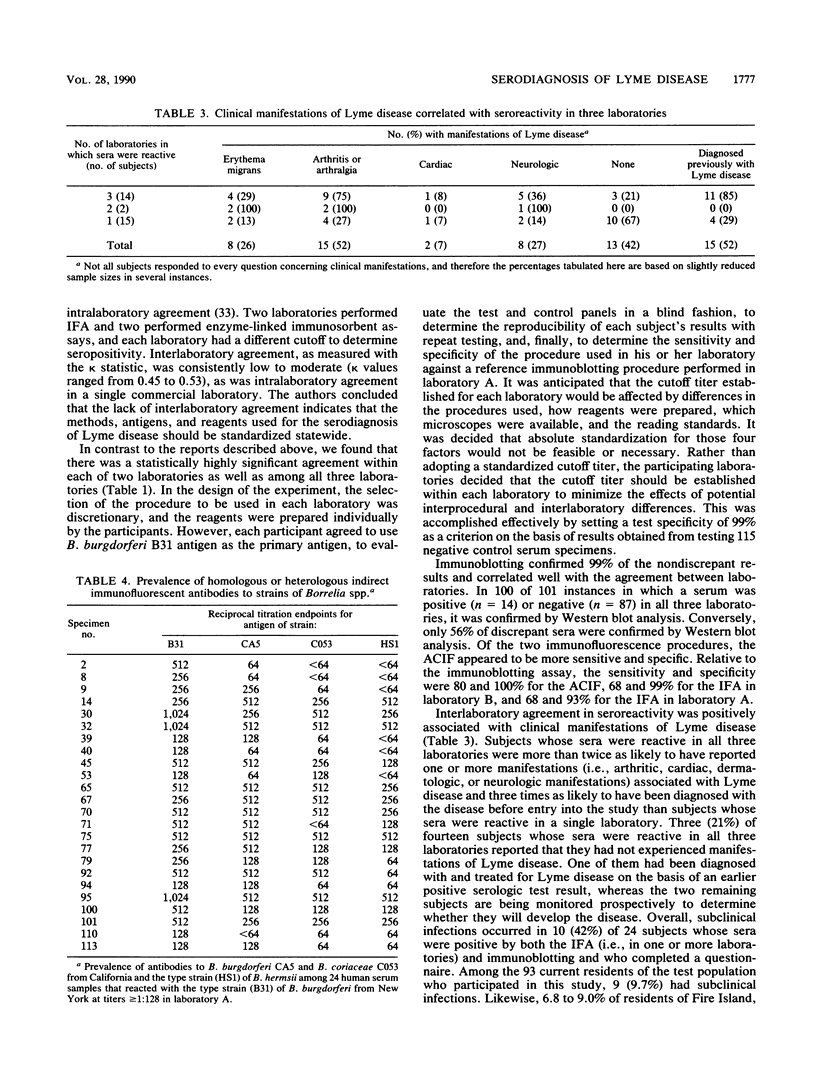
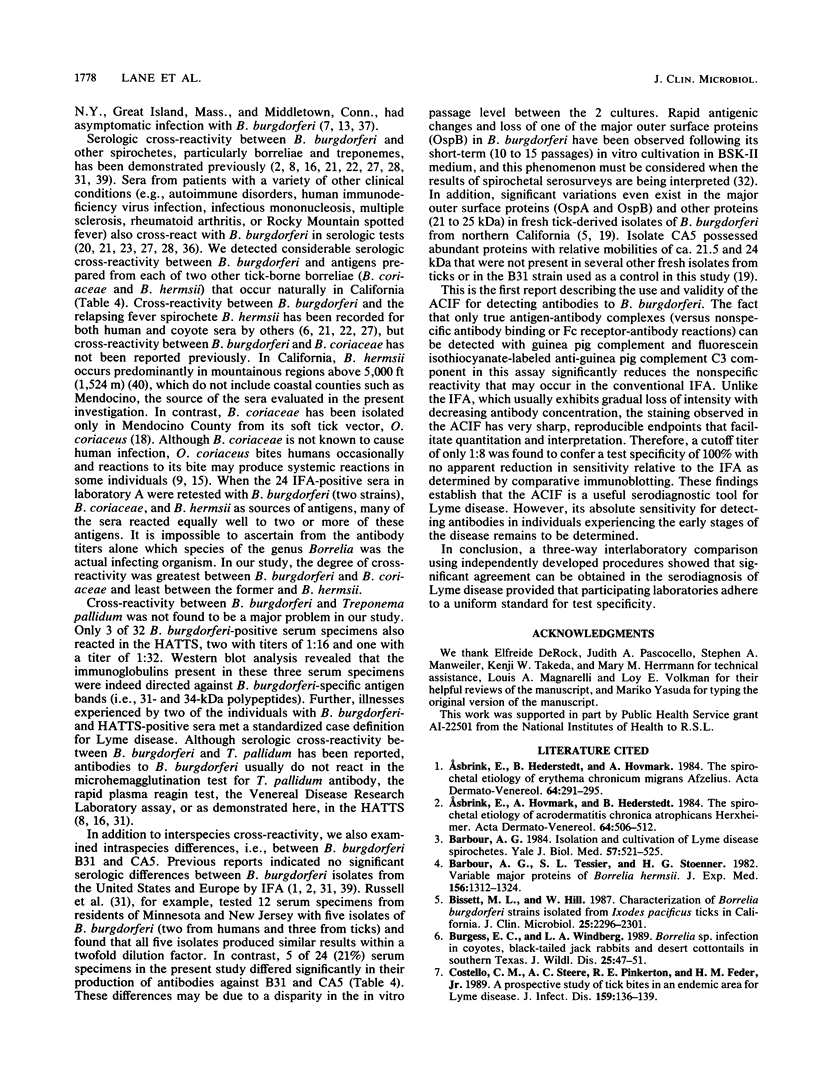
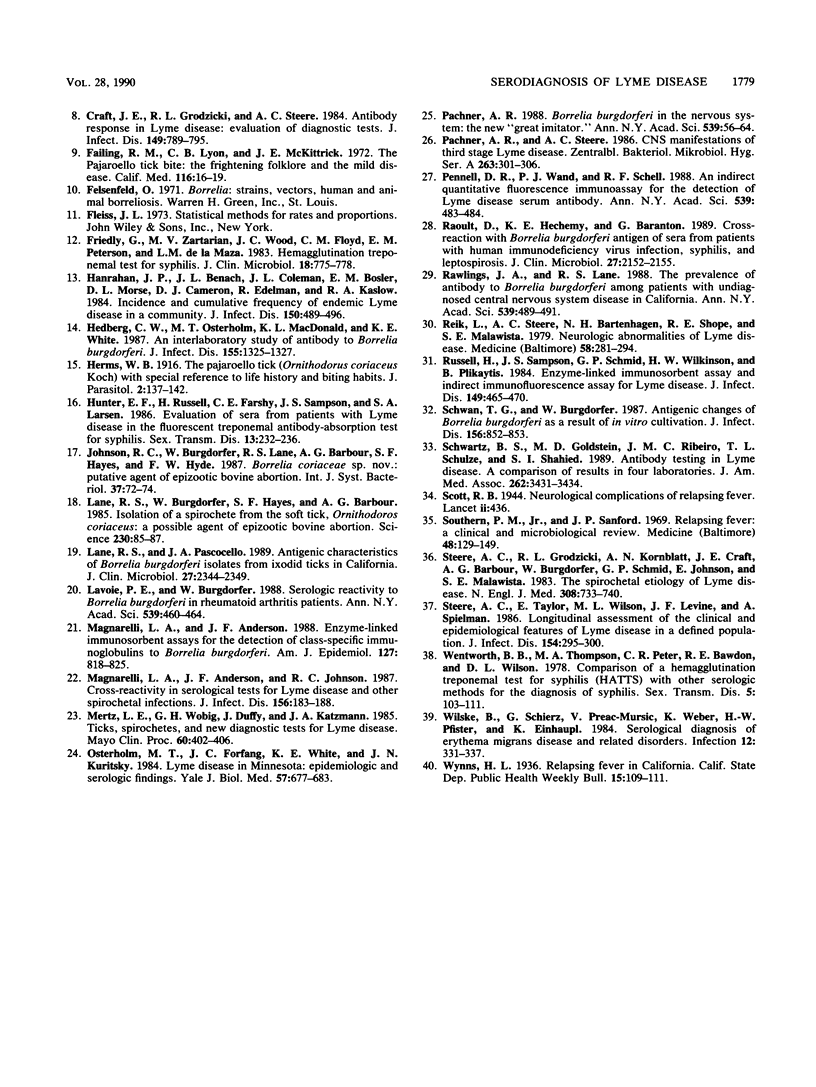
Selected References
These references are in PubMed. This may not be the complete list of references from this article.
- Asbrink E., Hederstedt B., Hovmark A. The spirochetal etiology of erythema chronicum migrans Afzelius. Acta Derm Venereol. 1984;64(4):291–295. [PubMed] [Google Scholar]
- Asbrink E., Hovmark A., Hederstedt B. The spirochetal etiology of acrodermatitis chronica atrophicans Herxheimer. Acta Derm Venereol. 1984;64(6):506–512. [PubMed] [Google Scholar]
- Barbour A. G. Isolation and cultivation of Lyme disease spirochetes. Yale J Biol Med. 1984 Jul-Aug;57(4):521–525. [PMC free article] [PubMed] [Google Scholar]
- Barbour A. G., Tessier S. L., Stoenner H. G. Variable major proteins of Borrellia hermsii. J Exp Med. 1982 Nov 1;156(5):1312–1324. doi: 10.1084/jem.156.5.1312. [DOI] [PMC free article] [PubMed] [Google Scholar]
- Bissett M. L., Hill W. Characterization of Borrelia burgdorferi strains isolated from Ixodes pacificus ticks in California. J Clin Microbiol. 1987 Dec;25(12):2296–2301. doi: 10.1128/jcm.25.12.2296-2301.1987. [DOI] [PMC free article] [PubMed] [Google Scholar]
- Burgess E. C., Windberg L. A. Borrelia sp. infection in coyotes, black-tailed jack rabbits and desert cottontails in southern Texas. J Wildl Dis. 1989 Jan;25(1):47–51. doi: 10.7589/0090-3558-25.1.47. [DOI] [PubMed] [Google Scholar]
- Costello C. M., Steere A. C., Pinkerton R. E., Feder H. M., Jr A prospective study of tick bites in an endemic area for Lyme disease. J Infect Dis. 1989 Jan;159(1):136–139. doi: 10.1093/infdis/159.1.136. [DOI] [PubMed] [Google Scholar]
- Craft J. E., Grodzicki R. L., Steere A. C. Antibody response in Lyme disease: evaluation of diagnostic tests. J Infect Dis. 1984 May;149(5):789–795. doi: 10.1093/infdis/149.5.789. [DOI] [PubMed] [Google Scholar]
- Failing R. M., Lyon C. B., McKittrick J. E. The pajaroello tick bite. The frightening folklore and the mild disease. Calif Med. 1972 May;116(5):16–19. [PMC free article] [PubMed] [Google Scholar]
- Friedly G., Zartarian M. V., Wood J. C., Floyd C. M., Peterson E. M., de la Maza L. M. Hemagglutination treponemal test for syphilis. J Clin Microbiol. 1983 Oct;18(4):775–778. doi: 10.1128/jcm.18.4.775-778.1983. [DOI] [PMC free article] [PubMed] [Google Scholar]
- Hanrahan J. P., Benach J. L., Coleman J. L., Bosler E. M., Morse D. L., Cameron D. J., Edelman R., Kaslow R. A. Incidence and cumulative frequency of endemic Lyme disease in a community. J Infect Dis. 1984 Oct;150(4):489–496. doi: 10.1093/infdis/150.4.489. [DOI] [PubMed] [Google Scholar]
- Hedberg C. W., Osterholm M. T., MacDonald K. L., White K. E. An interlaboratory study of antibody to Borrelia burgdorferi. J Infect Dis. 1987 Jun;155(6):1325–1327. doi: 10.1093/infdis/155.6.1325. [DOI] [PubMed] [Google Scholar]
- Hunter E. F., Russell H., Farshy C. E., Sampson J. S., Larsen S. A. Evaluation of sera from patients with Lyme disease in the fluorescent treponemal antibody-absorption test for syphilis. Sex Transm Dis. 1986 Oct-Dec;13(4):232–236. doi: 10.1097/00007435-198610000-00005. [DOI] [PubMed] [Google Scholar]
- Lane R. S., Burgdorfer W., Hayes S. F., Barbour A. G. Isolation of a spirochete from the soft tick, Ornithodoros coriaceus: a possible agent of epizootic bovine abortion. Science. 1985 Oct 4;230(4721):85–87. doi: 10.1126/science.3898367. [DOI] [PubMed] [Google Scholar]
- Lane R. S., Pascocello J. A. Antigenic characteristics of Borrelia burgdorferi isolates from ixodid ticks in California. J Clin Microbiol. 1989 Oct;27(10):2344–2349. doi: 10.1128/jcm.27.10.2344-2349.1989. [DOI] [PMC free article] [PubMed] [Google Scholar]
- Magnarelli L. A., Anderson J. F. Enzyme-linked immunosorbent assays for the detection of class-specific immunoglobulins to Borrelia burgdorferi. Am J Epidemiol. 1988 Apr;127(4):818–825. doi: 10.1093/oxfordjournals.aje.a114864. [DOI] [PubMed] [Google Scholar]
- Magnarelli L. A., Anderson J. F., Johnson R. C. Cross-reactivity in serological tests for Lyme disease and other spirochetal infections. J Infect Dis. 1987 Jul;156(1):183–188. doi: 10.1093/infdis/156.1.183. [DOI] [PubMed] [Google Scholar]
- Mertz L. E., Wobig G. H., Duffy J., Katzmann J. A. Ticks, spirochetes, and new diagnostic tests for Lyme disease. Mayo Clin Proc. 1985 Jun;60(6):402–406. doi: 10.1016/s0025-6196(12)60851-9. [DOI] [PubMed] [Google Scholar]
- Osterholm M. T., Forfang J. C., White K. E., Kuritsky J. N. Lyme disease in Minnesota: epidemiologic and serologic findings. Yale J Biol Med. 1984 Jul-Aug;57(4):677–683. [PMC free article] [PubMed] [Google Scholar]
- Pachner A. R. Borrelia burgdorferi in the nervous system: the new "great imitator". Ann N Y Acad Sci. 1988;539:56–64. doi: 10.1111/j.1749-6632.1988.tb31838.x. [DOI] [PubMed] [Google Scholar]
- Pachner A. R., Steere A. C. CNS manifestations of third stage Lyme disease. Zentralbl Bakteriol Mikrobiol Hyg A. 1987 Feb;263(3):301–306. doi: 10.1016/s0176-6724(87)80081-0. [DOI] [PubMed] [Google Scholar]
- Raoult D., Hechemy K. E., Baranton G. Cross-reaction with Borrelia burgdorferi antigen of sera from patients with human immunodeficiency virus infection, syphilis, and leptospirosis. J Clin Microbiol. 1989 Oct;27(10):2152–2155. doi: 10.1128/jcm.27.10.2152-2155.1989. [DOI] [PMC free article] [PubMed] [Google Scholar]
- Reik L., Steere A. C., Bartenhagen N. H., Shope R. E., Malawista S. E. Neurologic abnormalities of Lyme disease. Medicine (Baltimore) 1979 Jul;58(4):281–294. doi: 10.1097/00005792-197907000-00001. [DOI] [PubMed] [Google Scholar]
- Russell H., Sampson J. S., Schmid G. P., Wilkinson H. W., Plikaytis B. Enzyme-linked immunosorbent assay and indirect immunofluorescence assay for Lyme disease. J Infect Dis. 1984 Mar;149(3):465–470. doi: 10.1093/infdis/149.3.465. [DOI] [PubMed] [Google Scholar]
- Schwan T. G., Burgdorfer W. Antigenic changes of Borrelia burgdorferi as a result of in vitro cultivation. J Infect Dis. 1987 Nov;156(5):852–853. doi: 10.1093/infdis/156.5.852-a. [DOI] [PubMed] [Google Scholar]
- Schwartz B. S., Goldstein M. D., Ribeiro J. M., Schulze T. L., Shahied S. I. Antibody testing in Lyme disease. A comparison of results in four laboratories. JAMA. 1989 Dec 22;262(24):3431–3434. [PubMed] [Google Scholar]
- Steere A. C., Grodzicki R. L., Kornblatt A. N., Craft J. E., Barbour A. G., Burgdorfer W., Schmid G. P., Johnson E., Malawista S. E. The spirochetal etiology of Lyme disease. N Engl J Med. 1983 Mar 31;308(13):733–740. doi: 10.1056/NEJM198303313081301. [DOI] [PubMed] [Google Scholar]
- Steere A. C., Taylor E., Wilson M. L., Levine J. F., Spielman A. Longitudinal assessment of the clinical and epidemiological features of Lyme disease in a defined population. J Infect Dis. 1986 Aug;154(2):295–300. doi: 10.1093/infdis/154.2.295. [DOI] [PubMed] [Google Scholar]
- Wentworth B. B., Thompson M. A., Peter C. R., Bawdon R. E., Wilson D. L. Comparison of a hemagglutination treponemal test for syphilis (HATTS) with other serologic methods for the diagnosis of syphilis. Sex Transm Dis. 1978 Jul-Sep;5(3):103–114. doi: 10.1097/00007435-197807000-00005. [DOI] [PubMed] [Google Scholar]
- Wilske B., Schierz G., Preac-Mursic V., Weber K., Pfister H. W., Einhäupl K. Serological diagnosis of erythema migrans disease and related disorders. Infection. 1984 Sep-Oct;12(5):331–337. doi: 10.1007/BF01651147. [DOI] [PubMed] [Google Scholar]


